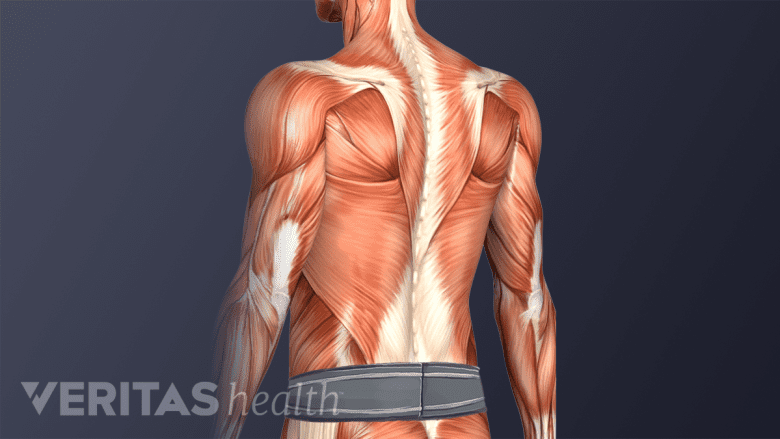Rehabilitation following SI joint fusion is determined by a combination of factors, such as the systems used to fuse the joint (such as instrumentation and bone grafting), the severity of symptoms prior to surgery, and the surgeon or physical therapist’s preferences for rehabilitation. Because the bone fuses during the healing time following the surgery, continued pain and other symptoms can be expected, but will typically begin to alleviate within a few weeks. The entire recovery process for sacroiliac joint fusion can take up to 6 months.
In This Article:
- What to Know About Sacroiliac Joint Fusion
- How Sacroiliac Joint Fusion is Performed
- Sacroiliac Joint Fusion Recovery
Pain Management After SI Joint Fusion
A sacral belt stabilizes the joint, reduces painful movements, and aids healing.
Most patients who undergo minimally-invasive fusion surgery are released from the hospital the next day able to walk, with prescriptions for one or more of the following:
- A walker or cane to reduce stress on the sacroiliac joint as it fuses
- A sacral belt, a type of pelvic brace, that is worn to stabilize the joint and limit motions that may exacerbate pain and impede healing
- Pain medication to manage post-operative pain and sensitivity, which may include over-the-counter pain relievers such as acetaminophen, as well as prescription painkillers such as opioid medications.
Additionally, using heat and ice therapy during healing can help manage pain caused by the surgery or brought on by a gradual return to activity.
- Applying ice to the low back and buttock around the surgical site can reduce inflammation, a common contributor to pain.
- Heat therapy, such as from a heating pad or adhesive heat wrap, can help reduce muscle tension and spasms caused by the surgery.
See Pain Management After Outpatient Spine Surgery
Physical Therapy Following Sacroiliac Joint Fusion
Hamstring stretches promote flexibility and reduce muscle tightness in the lower back.
The goal of post-surgical physical therapy is to rehabilitate function in the low back and pelvis in a controlled, gradual manner with minimized pain. Physical therapy is prescribed by the surgeon and/or specialist who recommended surgery, and typically includes a combination of the following:
- Passive Range of Motion stretches. Postoperative stretching may begin with passive exercise, in which a physical therapist moves the legs in slow, gentle motions to gradually expand the range of motion in the hips. These exercises help loosen and relax tight pelvic and hip muscles, which can help alleviate pain that lingers in the weeks following surgery.
- Stretching exercises. Active stretching exercises are part of any postoperative physical therapy to ensure the full range of motion in the low back, hip, and leg muscles is achieved. Specific stretches are advised by a physical therapist, and may include a lumbar rotation stretch, knee-to-chest stretch, or a kneeling lunge stretch, which focus primarily on the hip adductor and hip flexor muscles.
- Strengthening exercises. Exercise after SI joint fusion typically includes core, low back, and leg strengthening using the patient’s own weight for resistance or standard weight training.
See Strengthening Exercises for Sacroiliac Joint Pain Relief
Aerobic exercise. Aerobic exercise is added to a physical therapy program once muscles are stretched and strengthened to the point they can safely support activity. This aspect is typically added later in the physical therapy program, and may include walking on an elliptical, swimming, or using a stationary bike. Aerobic exercise is intended to increase muscle activity and circulation in the hips, legs, and lower back.
Water Therapy. Some physical therapists may advise stretching and strengthening exercises in a warm pool, which has the advantage of reducing pressure on the SI joint through the water’s buoyancy. Additionally, water provides natural resistance without the stress of land-based exercise, and the warm temperature can help relax tense muscles.
Returning to full weight bearing on the sacroiliac joint is usually gradual, requiring use of a support (such as a cane or walker) for about 4 weeks followed by toe-touch ambulation—or walking so the ball of the foot hits the ground before the heel—for the following 4 to 6 weeks.1Sachs D, Capobianco R. Minimally invasive sacroiliac joint fusion: one-year outcomes in 40 patients. Adv Orthop. 2013;2013:536128. A return to full weight-bearing may take longer, depending on the surgical methods used and progress made during physical therapy.
See Adjunctive Therapy for Sacroiliac Joint Pain
Potential Risks and Complications
As with any surgery, sacroiliac joint fusion poses risks and possible complications during or following surgery. During the procedure, risks include excessive blood loss or complications due to anesthesia; however, due to advancements in the technology used for minimally-invasive SI joint fusion, these complications have been significantly reduced.
One possible complication, Adjacent Segment Disease, arises when the fused joint no longer absorbs shock, referring pressure to another spinal segment that may not be able to support it, causing new pain and instability. In the case of SI joint fusion, pressure is typically referred to the L5-SI segment, also called the lumbosacral joint. One study found that new issues in the lumbar spine arose in about 5% of patients within 6 months of undergoing SI joint fusion.2Schoell K, Buser Z, Jakoi A, Pham M, Patel NN, Hsieh PC, Liu JC, WAng JC. Postoperative complications in patients undergoing minimally invasive sacroiliac fusion. Spine. Nov 2016; 16 (11): 1324-1332.
- 1 Sachs D, Capobianco R. Minimally invasive sacroiliac joint fusion: one-year outcomes in 40 patients. Adv Orthop. 2013;2013:536128.
- 2 Schoell K, Buser Z, Jakoi A, Pham M, Patel NN, Hsieh PC, Liu JC, WAng JC. Postoperative complications in patients undergoing minimally invasive sacroiliac fusion. Spine. Nov 2016; 16 (11): 1324-1332.






